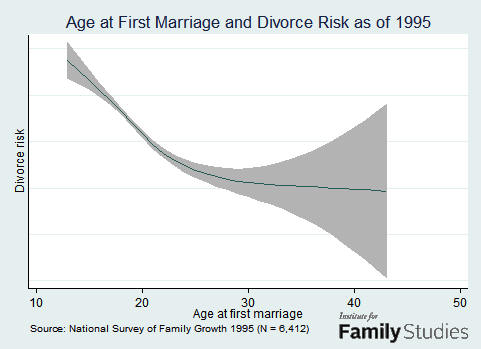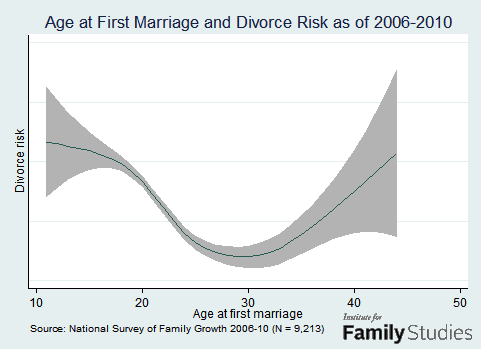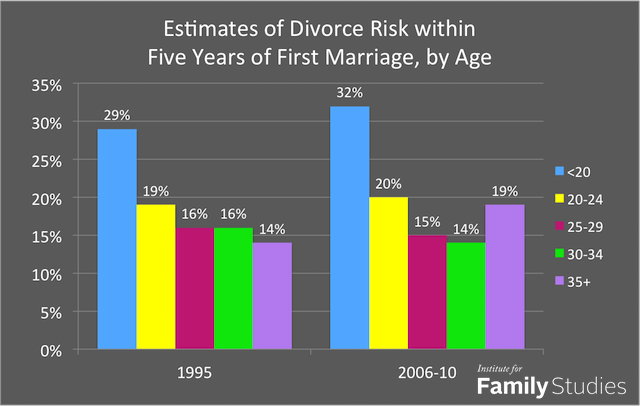Highlights
If you hope to avoid divorce, what’s the ideal age to get married? For years, it seemed like the longer you waited to marry, the better. That’s because the relationship between age at marriage and divorce risk was almost linear: The older you were, the lower the chances of divorce. Although teens still face an elevated divorce risk relative to older adults, my analysis of more recent data shows that those who tie the knot after their early thirties are now more likely to divorce than those who marry in their late twenties.
It’s no mystery why people who marry as teens face a high risk of divorce. Just recall your high school boyfriend or girlfriend. Along with the exhilaration of first love often came jealousy, insecurity, pressure from parents or friends, and tearful doubts about the future. Now imagine getting married under the same conditions. Scholars have long known that youthful marriage is a strong predictor of divorce. For instance, someone who marries at 25 is over 50 percent less likely to get divorced than is someone who weds at age 20. Most youthful couples simply do not have the maturity, coping skills, and social support it takes to make marriage work. In the face of routine marital problems, teens and young twenty-somethings lack the wherewithal necessary for happy resolutions.
Scholars have long known that youthful marriage is a strong predictor of divorce.
What about age at marriage past the twenties? Delaying marriage from the teens until the early twenties produces the largest declines in divorce risk, for totally understandable reasons: we’re all changing a lot more from year to year as teenagers than when we’re in our twenties or thirties. Our parents and friends are likely to disapprove of a teenage marriage, but their feelings probably won’t change much once we hit our mid-twenties. Still, earlier scholarship found that the risk of divorce continued to decline past that point, albeit at a milder rate (as the figure using 1995 data shows below). And why wouldn’t it? Couples in their thirties are more mature and usually have a sounder economic foundation. Conversely, youthful marriage is correlated with lower educational attainment, which compounds divorce risk no matter how old you are.

But what was true for decades no longer seems to be the case. I analyzed data collected between 2006 and 2010 from the National Survey of Family Growth (NSFG). The trick is to use statistical methods that permit nonlinear relationships to emerge (click here for more information on these methods). My data analysis shows that prior to age 32 or so, each additional year of age at marriage reduces the odds of divorce by 11 percent. However, after that the odds of divorce increase by 5 percent per year. The change in slopes is statistically significant. The graph below shows what the relationship between age at marriage and divorce looks like now.

This is a big change. To the best of my knowledge, it’s only recently that thirty-something marriage started to incur a higher divorce risk. It appears to be a trend that’s gradually developed over the past twenty years: a study based on 2002 data observed that the divorce risk for people who married in their thirties was flattening out, rather than continuing to decline through that decade of life as it previously had.
How can this change be explained? The first step to answering this question is to see if the pattern persists after adjusting for a variety of social and demographic differences between survey respondents. Indeed it does: thirty-something marriage continues to yield a higher divorce rate even after controlling for respondents’ sex, race, family structure of origin, age at the time of the survey, education, religious tradition, religious attendance, and sexual history, as well as the size of the metropolitan area that they live in. Note that the NSFG is a cross-sectional survey, which means that all respondent information was collected at a single point in time. Consequently the effects of education, religious attendance, and other impermanent demographic attributes on marital stability may not be causal. Results involving these variables should therefore be treated as provisional.
Past the age of 32 or so, the odds of divorce increase by 5 percent per year of age at marriage.
None of these variables seem to have much of an effect on the relationship between age at marriage and divorce risk. Additional tests revealed that the relation seems to function more or less the same for everyone: male or female, less or more educated, religious or irreligious, intact or nonintact family of origin, and limited versus extensive sexual history prior to marriage. For almost everyone, the late twenties seems to be the best time to tie the knot.
Does the experience of staying unmarried well past the age of 30 somehow make people unfit for a lasting marriage? It’s possible to envision a scenario where this might be the case, particularly in the form of a complicated relationship history. If you’ve had many boyfriends or girlfriends, your exes might play havoc with your marriage. They may offer the temptation of adultery. If you’ve had children with one or more of your exes, there could be “baby mama drama.” Indeed, having multiple sexual partners prior to marriage significantly increases the chances of getting divorced. Be that as it may, the number of prior sexual partners NSFG respondents had does not explain the relationship between age at marriage and marital stability. This result suggests that the mere experience of waiting past your early thirties to get married—a so-called “direct effect”—cannot explain why thirty-something marriages now have higher divorce rates than do unions formed in the late twenties.
Instead, my money is on a selection effect: the kinds of people who wait till their thirties to get married may be the kinds of people who aren’t predisposed toward doing well in their marriages. For instance, some people seem to be congenitally cantankerous. Such people naturally have trouble with interpersonal relationships. Consequently they delay marriage, often because they can’t find anyone willing to marry them. When they do tie the knot, their marriages are automatically at high risk for divorce. More generally, perhaps people who marry later face a pool of potential spouses that has been winnowed down to exclude the individuals most predisposed to succeed at matrimony.
There are obvious strengths and weaknesses to this sort of explanation. It’s easy to imagine that selection produces higher divorce rates for people past their early thirties. It’s also easy to provide evidence that selection is, in fact, responsible for high divorce rates (I have done so by controlling for potentially confounding variables like sexual history). It’s much harder to identify the mechanisms responsible for selection. Accordingly this should be a focus of research going forward.
The kinds of people who wait till their thirties to get married may be the kinds of people who aren’t predisposed toward doing well in their marriages.
The other pressing question about this theory concerns how matrimony has changed: marrying late only recently became associated with a heightened risk of divorce, and wouldn’t a similar process of selection have operated in the past? To answer this question we should ponder the social forces that discourage marriage in the United States. As of 2011, the median marriage age was 29 for men and 27 for women, the highest it’s been in decades for men and the highest ever for women. Although many explanations have been proposed for the record-setting rise in people’s age at marriage, two stand out. First, people are waiting to marry because they can’t afford it (or feel like they can’t afford it) due to wage stagnation. People now need more work experience to make the same wages, so they delay tying the knot. Second, there are now many more alternatives to matrimony. Young adults need not be married to have sex lives, and they are free to live with their partners out of wedlock.
I view the newly heightened divorce rate for people who wed after their early thirties as a sort of practical pushback against the social forces that are driving up the median age at marriage. Many people who delay marriage nowadays for financial reasons marry as soon as they feel they can afford it. These are the people who wed in their late twenties, the years of peak marital stability. The folks remaining in the pool of marriage-eligible singles are the kinds of people who aren’t well suited to succeed at matrimony (irrespective of their financial well-being). In previous years, when people didn’t feel like they were holding off on marriage because of money, the folks who waited into their thirties perhaps didn’t represent people ill-disposed to have lasting marriages. It’s also possible that some of the modern alternatives to marriage are too successful at siphoning people out of the marriage pool. Maybe some of the thirty-somethings who would have made good spouses now feel perfectly comfortable being single, or living with partners out of wedlock. Finally, we cannot definitively rule out causal arguments. With median marriage ages as high as they’ve ever been, perhaps some people who delay marriage get so used to single life that they make lousy spouses should they ever decide to give marriage a try.
This is all conjecture. But we do know beyond a shadow of a doubt that people who marry in their thirties are now at greater risk of divorce than are people who wed in their late twenties. This is a new development. This finding changes the demographic landscape of divorce, and lends credence to scholars and pundits making the case for earlier marriage.

Note: Unadjusted estimates of divorce in NSFG in 1995 and 2006-2010.
Update, 1:15 p.m.: Some readers have asked about the Y-axes in this post. The figures were generated using Generalized Additive Models, so the Y-axes are in a standardized metric that wouldn’t resonate with most readers. To illustrate what the divorce levels look like for different ages at first marriage, I estimate the percentages of people in each age group who will divorce after five years of marriage in the figure above. They are consistent with the graphs and numbers in the article.
Qualifications: There is right censoring for the 35+ group. What that means: the NSFG is a sample of adults ages 15-44, so people in the 35+ group are especially likely to have married within a year or two of the data collection. Thus their divorce rates appear lower than they’d actually be if these people had been more fully observed (i.e., had they been followed for a few more years). Also, the sample size for the 35+ group in 1995 is small (N = 74). This wasn’t of any great concern, because the story here is the same as it is for every other study on this topic: the divorce rate declines monotonically with age at marriage. The sample for the 35+ group for 2006-10, the people who are the focus of the new finding, is more than adequate (N = 379).
Nicholas H. Wolfinger is Professor of Family and Consumer Studies and Adjunct Professor of Sociology at the University of Utah. His next book, Soul Mates: Religion, Sex, Children, and Marriage among African Americans and Latinos, coauthored with W. Bradford Wilcox, will be published by Oxford University Press at the beginning of 2016. His other books include Understanding the Divorce Cycle: The Children of Divorce in Their Own Marriages; Do Babies Matter? Gender and Family in the Ivory Tower (with Mary Ann Mason and Marc Goulden); and Fragile Families and the Marriage Agenda (edited, with Lori Kowaleski-Jones).















